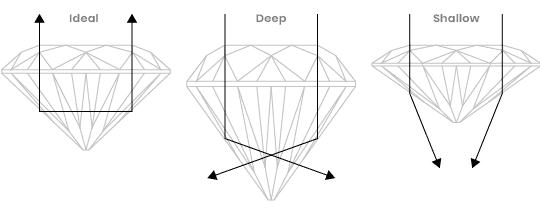Diamond Education
THE 4 CS
Diamond Anatomy.
Cut Grade
When your shopping for a diamond, the Diamond brightness and sparkle will keep you delighted long after you purchase.
Getting the most amazing brightness and sparkle requires excellent cutting skills, which reflects in the diamond’s cut grade. Of the 4 Cs, the ‘Cut’ has the most impact on the diamond’s appearance.

Understanding the 4 Cs of Diamond Shopping.
This Education page describes the Diamonds anatomy and the 4 Cs of Diamond. The 4 C’s, Cut, colour, clarity, and carat weight – these are the most important things to know when buying a diamond.

Clarity Grading
Diamonds, formed deep within the Earth, under extreme heat and pressure. Many contain unique marks, either internal (inclusions) or external (blemishes).
Diamond clarity refers to the absence of these inclusions and blemishes. Diamonds without Blemishes and inclusions are rare, which affects a diamond’s value.
A diamonds clarity grade from flawless FL to diamonds with very noticeable inclusions I3.
At least three Gemologiests using a 10X magnification will determine the clarity grade. The clarity grade is given based on the number, type, position and size of any flaw displayed on the stone.
Each gemmologist checks the stone without knowing the previous findings, To achieve the most accurate clarity grading.
The Clarity Scale contains 11 grades. Most diamonds grade into the VS (very slightly included) or SI (slight included) levels.
- Flawless (FL) – No inclusions or blemishes are visible to a skilled grader using 10× magnification.
- Internally Flawless (IF) – No inclusions and only blemishes are visible to a trained grader using 10× magnification.
- Very, Very Slight Included (VVS1 and VVS2) – Inclusions are difficult for a skilled grader to see under 10× magnification.
- Very Slightly Included (VS1 and VS2). Inclusions are minor and range from difficult to somewhat easy for a trained grader to see under 10x magnification.
- Slightly Included (SI1 and SI2) – Inclusions are noticeable to a trained grader under 10x magnification.
- Included (I1, I2, and I3) – Inclusions are detectable under 10× magnification and may affect transparency and brilliance.


Cut Grading
The cut quality gives a diamond its sparkle and brilliance. The allure and beauty of a particular diamond depend more on cut quality than anything else. Measuring devices and a visual assessment of the girdle and culet sizes to give the cut grade. Six cut grades range from excellent/ideal to poor. The visual examination of the Diamond to substantiate the accuracy of its grade. Visual inspecting of each diamonds optical symmetry to determine whether it displays a “hearts & arrows” pattern.


Diamond Colour Grading
The colour evaluation of gem-quality diamonds is the absence of colour. A perfect diamond has no hue (Colour), and so, a higher value. The Colour grading system that’s most used is D Colourless to Z light amounts of colour. Under Controlled lighting and viewing conditions, a colour grade is established. Three qualified gemologists generally carried out the colour-grading grad.


Carat (Size)
A Diamonds carat or weight of the diamond, a metric “carat” is 200 milligrams in weight. Each carat subdivides into 100 ‘points.’ This allows exact measurements. For instance, a diamond that weighs 0.25 carats or ‘twenty-five points. Gemologists weigh a diamond three times using precise equipment to gain accurate information. The devices kept in a controlled environment and calibrated at least twice a day.


Diamonds and Gems Conflict Free Diamonds Policy.
All the Diamonds and Gemstones that we buy at Diamonds and Gems come from legal suppliers.
We only buy from suppliers that are compliant with United Nations resolutions. The suppliers guaranteeing that they have come from conflict-free locations.
Conflict diamonds are also known as ‘Blood Diamonds‘. Blood Diamonds are used to fund illegal military operations, rebel, or terrorist movements. We understand that this could cause significant harm to local African Populations.
For this reason, we have a policy that we will comply with the Kimberley treaty Process and do not deal in conflict diamonds.
The Kimberley Process is a United Nations law. An international certificate program aimed at preventing the trade of conflict diamonds.
Looking For A Particular Diamond? or Just Browsing
Are you looking for a Diamond for some particular reason and need something of a specified Carat, Colour, and Clarity? Use our Diamond Finder to find that perfect Diamond for your project.


